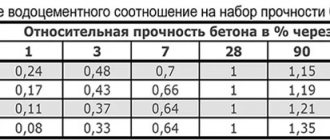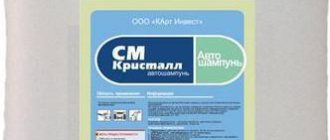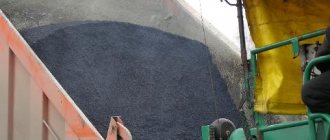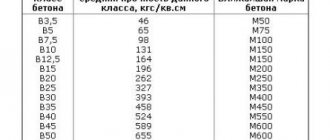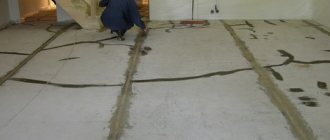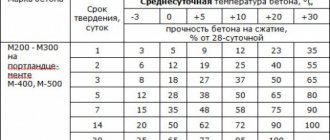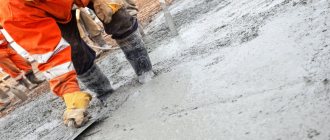what does it depend on and what does it influence?
Water saturation is one of the properties of any material. Its indicator is formed based on the ability to fill pores and cracks with liquid. Water saturation for asphalt concrete depends on its porosity. The value increases in case of insufficient compaction. The indicator will be normal if you strictly follow the production technology. Several samples are taken from the resulting asphalt. They are studied using a special technique.
Water saturation of asphalt concrete according to GOST 9128-2009 is determined in laboratory conditions. To do this, material is first collected from various areas of the surface. In the selected mode, the surface is filled with water. The laboratory technician measures the amount that will be absorbed by the structure. Additionally, freezing is performed. Low temperatures negatively affect the asphalt layer. If cracks are present, their volume increases noticeably. The situation can be avoided by additional compaction of the material.
Features of the term
For normal operation of asphalt, increased water saturation is unacceptable. If there is a deviation in the indicator, it is impossible to notice negative changes in the plane in the summer. Only specialists will be able to give a correct assessment after conducting the research. Increased water saturation is observed if a large number of pores can be detected on the surface with the naked eye. Against this background, rapid chipping of crushed stone from the surface is also observed.
An increased rate reduces the frost resistance of asphalt several times. The coating will deteriorate when cold weather sets in. If water has previously entered the surface, it begins to expand. Increasing volume results in deterioration of performance and integrity. The laws of physics lead to the fact that ice begins to break the asphalt from the inside. The surface breaks due to the pressure created by the liquid inside. The coating begins to progressively deteriorate, so further use is considered inappropriate.
Asphalt concrete pavement suffers due to prolonged moisture. Mineral grains are observed to crumble. It wears out quickly, causing potholes to appear. Water resistance directly depends on the density and the formation of stable bonds between the individual components. Thanks to this, it is possible to achieve the required level of adhesion. If the water saturation of asphalt concrete is below normal, then liquid diffusion can be observed over time. It penetrates under the bitumen film and destroys bonds. Mineral materials have positive potential. This property prevents the removal of bitumen film.
The liquid has the ability to penetrate into cracks in the material. The situation leads to a decrease in the strength of substances. Cracks weaken the properties of the structure. They begin to noticeably increase in size. Asphalt concrete loses its original strength properties. Liquids are also characterized by diffusion - the penetration of water into the material and stagnation. This leads to a wedging effect. The structure gets wet and then dries. Alternating action leads to an increase in porosity up to 7%. At the same time, the grain size decreases noticeably, and more liquid begins to accumulate in the pores.
Coarse concrete has many open pores. For fine-grained grains, their amount ranges from 30 to 40% of the total mass. Water saturation is calculated after swelling analysis and water resistance coefficient calculation. The indicator must be greater than 0.9. Only with prolonged water saturation can it be reduced to 0.8.
Frost resistance directly depends on the number of open pores. The bonds created between bitumen and minerals should also be taken into account. They suffer in spring and autumn. During this period, alternate freezing and freezing are observed. Against this background, cracks form, which increase with each cycle.
Frost resistance is usually expressed as a coefficient. It increases in each cycle, so the strength of the formed surface suffers. The indicator is lower for granite, but higher for limestone. Asphalt concrete can withstand more cycles only with the correct forming technology. Otherwise, destruction can be seen in the first season. The surface of such a sample cannot be used for a long period of time.
Reasons for changing properties
Road builders are interested in the issue of changing the water saturation of asphalt concrete, on which this indicator depends. The following factors are distinguished:
- During the process of creating the coating, the technology was violated. The workers did not comply with the necessary temperature requirements. For example, installation was carried out in the rain or at low temperatures. The indicator worsens if the roller has not passed over the surface a sufficient number of times. The equipment must also meet the requirements that GOST puts forward for it.
- A low quality asphalt mixture was used. It is not allowed to use a granular composition. The cooking recipe must also comply with GOST requirements.
Formula for calculation
Water saturation of asphalt concrete is measured as a percentage. Formula for calculating water saturation of asphalt concrete:
W= (m3 - m0)/(m1 - m2) 100%, where
m0 is the mass of a previously taken sample, if weighing is carried out in air.
m2 is the mass obtained after weighing in water.
m1 - the sample is first kept for half an hour in water, and then its weight in the air is measured.
m3 - the sample is saturated under vacuum conditions and then measured in air.
It is advisable to round the result to a decimal place. To form an informative picture, you will need to take the arithmetic average of several results.
The discrepancy in the obtained parameters cannot be more than 0.5%.
Ways to reduce
We have already figured out what affects water saturation of asphalt concrete. If the study revealed a deviation from the norm, then it is advisable to look for ways to reduce the indicator. The method of compaction of each layer is used.
In practice, results can only be achieved in the upper layers of asphalt. To do this, it is compacted using a gas burner. Additionally, you can run a heavy pneumatic roller over the surface. In the summer heat, asphalt begins to melt due to the negative effects of high temperature. The situation is ideal for additional surface compaction.
Theoretical data is difficult to implement on a large construction scale.
Asphalt concrete is a material characterized by a grain structure. It is first immersed in the solution. The components form a connection with each other and a structural formation is obtained. The service life of the coating depends on water saturation. If the technology is violated, the risk of voids forming inside the surface increases.
betonov.com
The present invention relates to testing road building materials and can be used to determine the water saturation of asphalt concrete.
There is a known method for the accelerated determination of the physical characteristics of asphalt concrete, which includes the laboratory production of asphalt concrete samples of the required diameter and height. The samples are cooled in air at room temperature for 90 minutes. After which they are weighed in air, then immersed for 30 minutes in a container with water at a temperature of 20±2°C, after which the samples are weighed in water, removed from the water, wiped and weighed again in air. Based on the data obtained, the average density of asphalt concrete is determined using known methods. Then the samples are placed in a container with water, the temperature of which is 20 ± 2 ° C, and placed in a vacuum - a device where a residual pressure of 2000 Pa (15 mm Hg) is created and maintained for 1 hour 30 minutes, after which the pressure is brought to atmospheric pressure and maintained for 1 hour. After this, the samples are weighed in water and in air and the water saturation and swelling of asphalt concrete are determined [Patent BY 5410 C1 G01N 33/42 - analogue].
The disadvantages of the analogue are that the known method does not allow one to reliably determine the water saturation of asphalt concrete, since the molding of the samples is carried out at a high temperature, and when the samples are cooled for 90 minutes, taking into account the high thermal conductivity of bitumen, the porous structure inside the sample does not have time to form and, accordingly, water saturation the sample will be incomplete.
A known method for determining water saturation involves making (molding) samples, weighing them in air at a temperature of 20±2°C, holding them in water at a temperature of 20±2°C for 30 minutes, then weighing them in water at a temperature of 20±2°C C and in air, evacuation in a vacuum chamber for 1 hour, at a residual pressure of 2000 Pa (15 mm Hg) and exposure in water for 30 minutes, after which the pressure in the vacuum chamber is brought to atmospheric and the samples are kept in water for 30 minutes, followed by re-weighing in water and air. [P. 13.2 GOST 12801-98 Mixtures of asphalt concrete road and airfield, tar road concrete, asphalt concrete and tar concrete. Test methods - prototype].
The known method has a significant drawback, namely that the test samples, subjected to evacuation in a vacuum chamber, are located directly in water. During the process of evacuation of samples, water clogs the pores, preventing air from escaping from the pores and microcracks, without ensuring more complete saturation of the pores with water, and this leads to a significant decrease in the accuracy of measurements when determining the water saturation of asphalt concrete samples.
The technical result is an increase in the accuracy of determining the water saturation of asphalt concrete.
The technical task is to increase the accuracy of determining the water saturation of asphalt concrete by increasing the filling of pores and microcracks with water while simultaneously reducing the costs of implementing the method.
Solution of a technical problem - the problem is solved by the fact that in the method for determining the water saturation of asphalt concrete, including making samples, weighing them in air at a temperature of 20±2°C, holding them in water at a temperature of 20±2°C for 30 minutes, then weighing the samples in water at a temperature of 20±2°C, removing excess moisture from the surface of the samples, then weighing them in air at a temperature of 20±2°C, evacuation in a vacuum chamber partially filled with water at a temperature of 20±2°C with a residual pressure of 2000 Pa (15 mm Hg), bringing the pressure to atmospheric, holding in water at a temperature of 20±2°C, for 30 minutes at atmospheric pressure to saturate the pores freed from air with water, re-weighing in water, removing excess moisture from the surface of the samples and weighing them in air, followed by calculation of water saturation, while evacuation of the samples placed on a stand inside a vacuum chamber above the surface of the water is carried out simultaneously with evacuation of the water for 30 minutes, and then after degassing of the samples and water, the samples immersed in water to saturate the pores freed from air with water.
The essence of the proposed method is to determine the amount of water absorbed by the sample at a given saturation mode. Water saturation is determined on samples prepared in the laboratory from a mixture or on core samples cut from an asphalt concrete pavement. To determine water saturation, dry asphalt concrete samples in the amount of 3 pcs. weighed in air at normal temperature and placed in a container filled with water at a temperature of 20±2°C for 30 minutes. After exposure, the samples are weighed in water in the same container at a temperature of 20±2°C to determine the density of the sample. Then the samples are taken out of the water and wiped with a damp cloth to remove excess water from the surface and re-weighed in air at a temperature of 20±2°C. After this, the samples are placed on a stand placed inside a vacuum chamber, partially filled with water at a temperature of 20±2°C, with the samples located above the surface of the water. Then, the process of evacuation of water and samples is carried out simultaneously at a residual pressure of 2000 Pa (15 mmHg) for 30 minutes. The process of evacuation of water and samples allows for degassing of water and freeing the internal pores of the samples from air. After the evacuation is completed, the samples (without removing them from the vacuum chamber) are tipped into the water of the vacuum chamber to completely saturate the pores and microcracks with water and at the same time the pressure is brought to atmospheric pressure, the samples are kept in water at a temperature of 20±2°C for 30 minutes, for complete filling of the vacated pores with water, i.e. their water saturation. Then the samples are removed from the vacuum chamber and placed in a container of water at a temperature of 20±2°C for weighing in water. After this, the samples are taken out, excess water is removed from the surface with a damp cloth and weighed in air at normal temperature.
According to well-known mathematical calculations, the density of asphalt concrete is first determined:
Where,
g is the mass of the sample, in a dry state, suspended in air, g;
ρB is the density of water equal to 1 g/cm3;
g2 is the mass of the sample kept for 30 minutes in water and resuspended in air, g;
g1 is the mass of the sample suspended in air after evacuation, g;
Next, mathematical calculations are used to determine the water saturation of 3 samples:
Where,
g is the mass of the sample, in a dry state, suspended in air, g;
g1 is the mass of the sample suspended in water, g;
g2 is the mass of the sample kept in water and suspended in air, g;
g5 is the mass of a water-saturated sample suspended in air, g;
At the end of the tests, the arithmetic mean value of water saturation of one sample is calculated. The arithmetic mean value of three determinations of one sample, rounded to the first decimal place, is taken as the result of determining water saturation.
The proposed method for determining the water saturation of asphalt concrete due to more complete filling of pores and microcracks with water during separate evacuation of water and samples allows, in comparison with the prototype, to increase the accuracy of determining the water saturation of asphalt concrete, to reduce the holding time of asphalt concrete samples (from mixtures with viscous organic binders) in a vacuum chamber , reduce the time of the method, and, consequently, reduce the costs of power consumption and the costs of implementing the method itself, which is a new technical result of the proposed method.
Examples of specific performance.
For tests to determine the water saturation of asphalt concrete (from mixtures with viscous organic binders), three samples were made for different types of asphalt concrete with the composition of the mineral part: those belonging to type A (crushed stone - 53%; crushed crushed stone screenings - 40%; mineral powder - 7%) , type B (crushed stone - 45%; crushed stone screenings - 46%; mineral powder - 9%), type B (crushed stone - 35%; crushed stone screenings - 50%; mineral powder - 10%), type ShchMA (crushed stone fr 5-10 mm - 25%; crushed stone fr. 10-15 mm - 43%; mineral powder - 12%; crushed stone screenings - 20%).
Based on well-known mathematical calculations, the density and water saturation of various types of asphalt concrete were determined:
Example
Tests were carried out on asphalt concrete samples belonging to type A.
3 samples were made and cooled in air for 4 hours at a temperature of 20±2°C, then they were weighed in air and immersed for 30 minutes in a container with water at a temperature of 20±2°C, after exposure the samples were weighed in water in the same container . Then the samples were taken out of the water and wiped with a damp cloth to remove excess water from the surface and re-weighed in air at a temperature of 20±2°C. After this, the samples were installed on a stand placed inside the chamber of the vacuum installation, partially filled with water at a water temperature of 20 ± 2°C, while the samples were installed on the stand so that they were above the surface of the water. Then, the process of evacuation of water and samples was carried out simultaneously at a residual pressure of 2000 Pa (15 mmHg) for 30 minutes. After the evacuation was completed, the samples (without removing them from the vacuum chamber) were tipped into the water of the vacuum installation chamber to completely saturate the pores and microcracks with water and at the same time the pressure was brought to atmospheric pressure, the samples were kept in water at a temperature of 20±2°C for 30 minutes. Then the samples were removed from the vacuum chamber and placed in a container with water at a temperature of 20±2°C to be weighed in water. After this, the samples were taken out, excess water was removed from the surface with a damp cloth, and weighed in air at normal temperature.
In the same way, tests were carried out for asphalt concretes belonging to types B, B and ShchMA. The test results to determine the density and water saturation of manufactured asphalt concrete samples are given below in tables 1, 2.
As can be seen from Table 1, the results of the average density of asphalt concrete obtained using the prototype and the claimed method have minor discrepancies, namely for type A the discrepancy is 0.01 g/cm3, for type B 0.01 g/cm3, for type B and ShMA there are no discrepancies.
According to the above test results (Tables 1 and 2), we can conclude that with a slight difference in the average density of asphalt concrete, the water saturation values for different types of asphalt concrete have significant differences. The water saturation of asphalt concrete belonging to type A in relation to the prototype increased by 31.4%, to type B by 33.3%, to type B by 41.03%, to type ShMA by 27.6%.
In addition, the proposed method allows to reduce the testing time and, accordingly, reduce the costs of its implementation.
A method for determining the water saturation of asphalt concrete, including making samples, weighing them in air at a temperature of 20±2°C, holding them in water at a temperature of 20±2°C for 30 minutes, then weighing the samples in water at a temperature of 20±2°C, removing excess moisture from the surface of the samples, their subsequent weighing in air at a temperature of 20±2°C, evacuation in a vacuum chamber partially filled with water at a temperature of 20±2°C with a residual pressure of 2000 Pa (15 mm Hg), finishing pressure to atmospheric pressure, holding in water at a temperature of 20±2°C for 30 minutes at atmospheric pressure to saturate the pores freed from air with water, re-weighing in water, removing excess moisture from the surface of the samples and weighing them in air, followed by calculation of water saturation, characterized in that the evacuation of samples placed on a stand inside a vacuum chamber above the water surface is carried out simultaneously with the evacuation of water for 30 minutes, and then, after degassing of the samples and water, the samples are immersed in water to saturate the pores freed from air , water.
DURABILITY OF ASPHALT CONCRETE
Number of views of the publication DURABILITY OF ASPHALT CONCRETE - 1301
Asphalt concrete is a material obtained by compacting a specially calculated and prepared mixture of crushed stone, sand, mineral powder and bitumen. Based on the degree of saturation of asphalt concrete with the main structure-forming components, it is divided into basal, pore and contact structures.
In asphalt concrete with a basal structure, the grains of the large component do not have mutual contacts and are, as it were, immersed in the mortar part. Further saturation of asphalt concrete with structure-forming components leads to contact of grains through thin layers of binder, a pore structure is formed, which creates a dense frame of grains capable of absorbing significant external forces. In this case, the volume of asphalt concrete solution corresponds to the volume of voids in the crushed stone frame. A further increase in the crushed stone content leads to the formation of a contact structure in which the volume of voids in the crushed stone framework exceeds the volume of the asphalt solution.
Asphalt concrete, which has reversible microstructural bonds, based on temperature, can be in the following structural states: elastic-brittle, in which the mineral skeleton of asphalt concrete is strictly fixed by vitrified layers of bitumen; elastic-plastic, when the grains of the mineral skeleton are connected to each other by layers of bitumen, which exhibit elastic and elastic properties at stresses not exceeding the yield strength, and elastic-viscous properties at high stresses; viscous-plastic, in which the grains of the mineral skeleton are connected by semi-liquid layers of bitumen.
In addition to temperature factors, asphalt concrete is exposed to atmospheric and melt water; water penetrates the pores of asphalt concrete and weakens the mutual connection of mineral materials with the binder film. For this reason, the strength of asphalt concrete is assessed based on the results of compression tests of cylindrical samples at temperatures of +50, +20 and 00 C. If at temperatures of +500 C the lower limit of strength is limited (1.0-1.2 MPa), then at at 00 C the upper limit of strength is limited (no more than 12 MPa). The strength indicator at +500 C characterizes the shear resistance of asphalt concrete at high temperatures and the material’s resistance to the formation of plastic deformations in the coating. The strength indicator at 00 C indirectly characterizes the crack resistance of asphalt concrete at low temperatures.
Water resistance and frost resistance. Asphalt concrete pavements, when moistened for a long time, due to the weakening of structural bonds, can be destroyed due to the spalling of mineral grains, which leads to increased wear of the pavement and the formation of potholes. The water resistance of asphalt concrete depends on its density and the stability of adhesive bonds. Water, as a polar liquid, well wets all mineral materials and therefore, with prolonged moistening, diffusion of water under the bitumen film is possible. At the same time, mineral materials with a positive surface charge potential (dolomite, limestone, calcite) are more likely to prevent the displacement of bitumen film by water than materials with a negative surface potential (quartz, granite, andesite).
Water, penetrating into microdefects in the structure of asphalt concrete, leads to an adsorption decrease in the strength of the material due to a decrease in the surface energy of the crack walls and weakening of the structural bonds at the tip of the crack as it develops. The natural decrease in the strength of asphalt concrete with an increase in the period of its exposure to water is explained by the gradual diffusion of water into the material and the ever-increasing wedging effect of water. The structure of asphalt concrete is significantly destroyed by its frequent alternate wetting and drying. The water resistance of asphalt concrete is greatly influenced by its porosity, which is 3-7%. As the grain size in asphalt concrete decreases, the number of closed pores inaccessible to water increases. Posted on ref.rfTak, in coarse-grained concrete almost all the pores are open, and in fine-grained concrete the open pores are 30-40%. Water resistance is determined by the amount of water saturation, swelling and the water resistance coefficient (the ratio of the strength of water-saturated samples to the strength of dry ones). The water resistance coefficient must be no less than 0.9, and with prolonged water saturation (14 days) no less than 0.8.
The frost resistance of asphalt concrete is mainly related to the number of open pores and the nature of the interaction between bitumen and mineral material. The most destructive effect is caused by the alternating freezing and thawing of asphalt concrete that occurs in spring and autumn. Alternating temperatures lead to the appearance of cracks that develop during repeated cycles of freezing and thawing.
The frost resistance of asphalt concrete is usually assessed by the frost resistance coefficient Km, which shows a decrease in tensile strength after a certain number of freezing and thawing cycles. The frost resistance of asphalt concrete on granite material is significantly lower than on limestone. This is explained by the fact that the nature of the bitumen-granite bond is physical, while the bitumen-limestone bond is physical-chemical. The stresses that arise when water freezes easily destroy physical bonds and are unable to destroy chemical ones.
Wear resistance. Wear of asphalt pavement occurs under the influence of friction forces caused by the slipping of car wheels over the surface of the pavement and vacuum forces arising under a moving car. The wear of the coating is determined by: abrasion of its structural elements, separation and removal of sand grains and crushed particles of crushed stone from its surface. The higher the wear resistance of asphalt concrete, the higher its density, the higher the hardness of the mineral materials included in its composition and the higher the adhesion of crushed stone and sand grains to bitumen. Asphalt concrete prepared on granite crushed stone is more wear-resistant than concrete on limestone crushed stone. Asphalt concretes, which contain crushed stone with the least crushability during rolling, have high wear resistance. The abrasion of asphalt concrete pavement during heavy traffic is 0.3-1.0 mm per year.
referatwork.ru
Asphalt concrete is marked according to the following type:
- based on the basic composition, gravel, crushed stone, and sand asphalt are distinguished;
- according to the category of bitumen, the material is divided into hot and cold;
- by fraction structure: sandy, fine-grained and coarse-grained;
- Based on residual porosity, asphalt concrete is divided into high-density and dense, porous and high-porosity building materials;
- by purpose: industrial, road, airfield, decorative.
Before use, each category of building mixture is tested for compliance with technical and regulatory requirements. Testing of asphalt concrete is based on the rules outlined in GOST 12801-98. Another document regulating the quality parameters of asphalt pavement, SP 78.13330.2012.
Construction of foundations in water-saturated soils
Naturally, special attention is paid to structures in direct contact with the ground during design. The main task is to find the most optimal solution that will help eliminate uneven shrinkage of the building.
- To do this, when constructing strip and monolithic slab supports, measures such as increasing the area of support of the foundation and changing the depth of its foundation are used. If there is a dense top layer at the bottom of the pit, a support cushion is installed under the foundation strip, and it can be not only bulk, but also concrete (monolithic or prefabricated). A sand cushion is also required in this case.
Foundation strip resting on a concrete pad
In those places where there is a likelihood of the greatest settlement, a deeper basement can be provided or, conversely, the level of the base of the foundation rises higher.
Building responsibility levels: what are they?
In general, the design of the zero cycle of a building is related to the level of its responsibility. The state standard establishes three such levels: increased, normal and decreased. The first level includes all industrial facilities, high-rise buildings and unique structures.
Construction with a reduced level of responsibility
- Residential buildings and other mass-produced buildings belong to the second level. The category of objects of reduced responsibility includes pavilion-type buildings and small architectural forms. These include gazebos, greenhouses, garages, small warehouses and bathhouses - everything that is being built on personal plots and summer cottages.
Note! The foundations of private mansions, townhouses, cottages and comfortable country houses are subject to requirements corresponding to the II (normal) category of responsibility. This means that during their construction, geological surveys must be carried out and a foundation design must be developed, tied to the actual conditions of the site.
Construction of a house with a basement on a strip foundation
And here are the recommendations given by experts for choosing a foundation design for buildings of a normal level of responsibility:
| Type of soil | Recommended foundation type |
| Sands of medium and high density; Clay soils with a lower fluidity index of 0.75 | Build a house without a basement, on a shallow or shallow foundation. |
| Non-heaving soils | Columnar, strip, monolithic slab foundations. A basement can be provided. |
| Heaving soils | Only shallow strip or slab foundation. No basement. |
| Water-saturated biogenic soils: peats, silts, loose sands, fluid clays | Piles or slab foundations. Basements are out of the question. |
How to compact the foundation
In large-scale construction, a variety of methods are used to reduce soil moisture levels (see How to drain an area with a high groundwater level). This includes the installation of vertical drains, the installation of drainage wells, freezing of the soil, and the installation of wellpoints. But what should an ordinary private owner do if he decides to build a house on his own?
- The main means of escape from ground moisture in this case is a cushion of sand and gravel under the base of the foundation. With its help, you can reduce the depth and size of it, better distribute the pressure on the ground and make the settlement more uniform. To create a bed for the foundation, sand, sand-gravel mixture, and crushed stone are used.
Scheme of a monolithic foundation on a sand cushion
- Ideally, this is two layers: first sand, then gravel. Their thickness is determined based on the quality of the soil and the size of the foundation, and can be quite large. But, for example, when preparing the foundation for a small private house, a pillow can be poured from sand alone. Only in this case, the thickness of the bulk layer will be, for example, not twenty, but thirty centimeters.
- It is only important that the sand is coarse-grained and in no case contains clay impurities, since the water in such a cushion will stagnate. When developing a pit, it is necessary to take into account its thickness. As has already been noted, sealing the pillow as much as possible is of great importance, and this must be done correctly.
- It is clear that a vibrating plate should be used for this purpose, because a pit is not a hole for a fence post, and you cannot compact a 30 cm cushion by hand. There is one more, very significant nuance: everyone knows that dry soil, and especially sandy soil, cannot be compacted at all.
Compacting a sand cushion
- Therefore, when installing a pillow under the foundation, you need to know what the moisture content of the sand is. If it turns out to be below 5%, then according to the norms it must be additionally moistened, and the amount of water is determined by calculation. Pour the pillow in stages, tamping each layer separately, but it is not recommended to wet the sand directly during compaction.
Keep in mind that if the groundwater is closer than half a meter to the bottom of the pit, it makes no sense at all to build a buried strip or slab foundation, since it can easily float as a result of the influence of frost heaving forces. In this situation, it is better to give preference to the pile option, and you will be offered short instructions on its arrangement in the next chapter.


